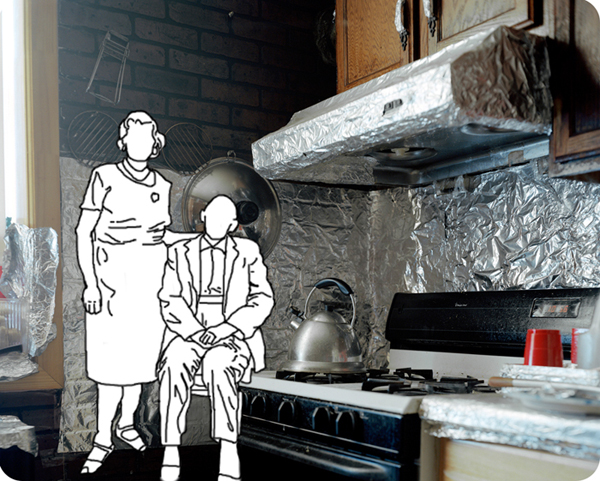
Untitled (Can I Come Home With You?) by Jane Tam
New American Photography at Fotofest: Aaron Schuman Selects 11 Photographers
Photographing the present as if it were already the past may well be what many photographers aspire to achieve as they look through a camera lens. One may look at photography today, at the never ending number of images made and realize that it has all been done before, someone has seen the eyes of the poor, or the light on a Paris street, the shadows created by waves of sand, the irony in a street sign, or the pair sitting in a cafe. When Aaron Schuman, the editor of SeeSaw magazine realized that photography was not a competition, it shifted his perspective. For him, photography is informative, useful, fun and it engages and enriches his life. It may have been done before, but not in the same way. Not with the eyes of the 21st century photographer. And this, in essence, is what Whatever was Splendid: New American Photographs at the Fotofest Biennial in Houston is all about and what his online magazine represents. The seeing and the seeing something that someone else saw.
“I think [Walker] Evans had a unique idea, which really distinguishes him from many other artists. He set himself up as a historical model to see the present as if it were already the past. And if he could do that at the time, he could stand for all time, and I think that his success is that he achieved his goal to photograph what was most American about America, but also to photograph those things in the present with the eye of tradition. And I think that those pictures are timeless.” –Jeff Rosenheim, the curator of photography at the Metropolitan Museum of Art in New York,”The Hungry Eye,” (A NewsHour with Jim Lehrer Transcipt, PBS, April 6, 2000)
Aaron Schuman studied the catalog for Walker Evans 1938 exhibit at the Museum of Modern Art American Photographs. (The first exhibition at MoMA devoted to the work of a single photographer.) He found in Evans work images, symbols and signs that have come to represent America–cars, broken down cars, mechanics fixing cars, and cars in relationship with the American landscape. He also saw advertising images and signage, flood refugees, issues of race and class. He also noticed that Evans often captured other photographs in his images.

Hank Willis Thomas, "Available in a Variety of Sizes and Colors" 1977/2007, 2007 Digital C-print, Ed. 1/5 32 x 30 in. (81.3 x 76.2 cm)
“American Photographs is very much about photographing America, but its about photography as well,” Schuman said via telephone from his office is England.During Evans time, photography was still a relatively new medium. But the similarities between the great depression and our current economic situation forced parallel explorations. Schuman, an ex-patriot wondered, how did Americans use photography today. And what is American? But more than some nostalgic look back, he put together an exhibit that explores as Walker Evans did a way of seeing the link between now and the past, “recognizing that what exists today is part of a long standing tradition and chronology,” Schuman said.
After a lengthy online search, Schuman selected 11 photographers: Will Steacy, Michael Schmelling, Greg Stimac, Tema Stauffer, Jason Lazarus, Jane Tam, Richard Mosse, Craig Mammano, Todd Hido, Hank Willis Thomas, and RJ Shaughnessy. It wasnt until he arrived in Houston that the photos he had selected and studied as visual ideas became visual objects. The scale of work by Hank Willis Thomas and Richard Mosse he called “striking and exciting.” With Todd Hido it was “the physical nature of his prints. They are subtle, beautiful objects and seductive in their ideas and concepts.”

Hank Willis Thomas, "Are You the Right Kind of Woman for It?" 1974/2007, 2007 Digital C-print, Ed. (76.2 x 99.4 cm)
Consciously or not, the photographers in Whatever was Splendid have expanded on the themes, clues, symbols, and strategies that Evans explored in American Photographs. “They all inherently possess a somewhat familiar “˜burrowing eye, and share a determination to record, testify, and salvage what they can of their own precarious age for its survivors. And just like Evans, they have both reinvigorated American photography and redefined their country””conceptually, aesthetically, culturally, politically, historically, photographically, and so on””within very contemporary terms,” Schuman wrote recently in the Telegraph. (Hank Willis Thomas, Are You the Right Kind of Woman For It, from the series Unbranded, 1974/2007. Courtesy of the artist and Jack Shainman Gallery.)
Its an idea close to Schuman. As an expatriot living in England, he feels he has become the token American. That people associate and assume that he is “American,” something her never considered himself to be while growing up and in the U.S., at least not in the typical sense. “I didnt have a gun and I wasnt captain of the football team,” he said. He has questioned what is American Photography and what does it mean? Today, when hes not doing freelance work, or teaching, or editing his online photography magazine SeeSaw, he is photographing the American presence abroad. A recent shoot took him to Southern Spain where Sergio Leone, the Italian filmmaker shot his spaghetti westerns.
“Im trying to make American photographs without being in America,” he said. He also shares his love for photography with anyone who cares to read or see through his online magazine SeeSaw a venture he started in 2004. Its a venture of love and something he does for passion and not money. The quarterly publication features profiles of photographers and artists and has gained a reputation as a place for emerging photographers to share their work. It became a way for Schuman to talk with his heros and photographers that he admired and to share those conversations with others. A way to see and to see what others already saw.
